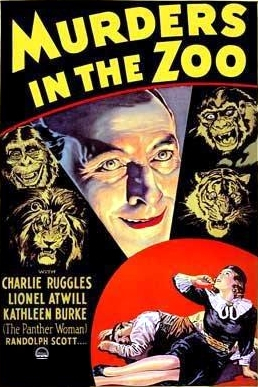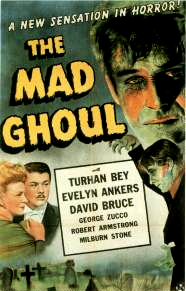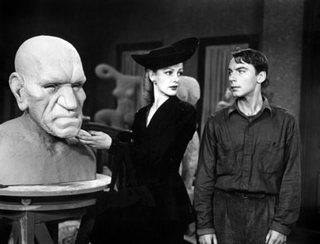
 |
|
|
|
A year or so ago Turner Classic Movies presented a series of almost-lost pre-code RKO movies; now they've come out with another branded grouping of vintage pictures available for sale through the TCM Website. The Universal Cult Horror Collection is an assortment of odds 'n' ends from the studio's budget-conscious 1940s (plus a notorious pre-code shocker from Paramount), dominated by mad doctors and their misguided experiments. All but one is a "B" picture, and each is barely over an hour long. Glossy photography and high technical standards separate them from the low-end product being ground out by Monogram and P.R.C.. Mad doctor favorite Lionel Atwill is the closest we get to a horror star. The first offering is actually a Paramount Picture acquired by Universal's parent company MCA in a library buyout. Horror connoisseurs class the weird pre-code thriller Murders in the Zoo with the most sadistic shockers of the day: Edgar G. Ulmer's perverse The Black Cat; the Sci-fi vivisection classic The Island of Lost Souls; the cruel The Most Dangerous Game. Murders enlists Lionel Atwill (Mystery of the Wax Museum) as zoo big game hunter Eric Gorman, a maniac fond of murdering men attracted to his wife Evelyn (Kathleen Burke, the sexy 'panther woman' of Lost Souls). Gorman uses poison from a large black mamba viper to kill one unlucky suitor, and throws another victim to the hungry crocodiles in his reptile enclosure. Also threatened are handsome researcher Jack Woodford (Randolph Scott in an early role) and his assistant / fiancée Jerry Evans (Gail Patrick). In for bumbling comic relief is top-billed Charles Ruggles; he plays a publicity hack deathly afraid of wild animals. Despite the clowning Murders in the Zoo has a sickly air about it. Pleasant by day, the zoo is by night a creepy death trap. Even Dr. Gorman's racy pre-code dialogue has a twisted quality, as when one of Evelyn's admirers drops dead right in the middle of a fancy party: "What do you think, that I came to dinner with a black mamba in my pocket?" The dark-eyed Kathleen Burke generates a genuine erotic charge, while Lionel Atwill makes the most of Gorman's emotional derangement. The gruesome murders, he claims, are proof of the depth of his love. 
Edward Sutherland's direction is okay but the film's best artistic contribution is Ernest Haller's evocative cinematography. The one unforgettable scene comes right at the beginning. To retaliate against a colleague who has dared to kiss Evelyn, the jealous Gorman sews the man's mouth shut without anesthesia. The victim then stumbles into a full-face close-up, revealing shocking makeup far more graphic than anything one would expect in a 1933 film from Hollywood's most glamorous studio. Murders in the Zoo has a couple of moments of animal cruelty -- big cats loosed together in a confined space appear to be really mauling each other. The story logic wears thin at times, as when Atwill discovers that a conveniently located chain just happens to open all of the animal cages at the same time. But the film's sadism and perversity ensure its reputation as a rare item. The Production Code would soon banish this kind of macabre entertainment from film screens. The disc set jumps directly to the "B" picture unit at Universal, which had recently been turned over to a producer who specialized in series westerns. Many of Uni's 1940's pictures are credited only with associate producers with limited decision making authority. Future film noir director Joseph H. Lewis (The Undercover Man, Gun Crazy) can't do much with The Mad Doctor of Market Street (1942) a foolish hybrid that begins as a crime story, advances to a shipwreck and ends as a second-rate jungle adventure. Lionel Atwill returns as Dr. Ralph Benson, a researcher whose illegal experiment naturally involve reviving the dead. He accidentally kills his test subject, an unemployed man trying to take care of his family. Benson makes his escape by booking passage on an ocean liner, and hiding among the passengers. Top billing again goes to the comedy relief. Ditzy husband hunter Una Merkel and punchy prizefighter Nat Pendleton aren't helped by the weak jokes in the script. They and Dr. Benson share a lifeboat with Claire Dodd and Richard Davies, the film's romantic couple. Hostile natives prepare to toss the strangers into a bonfire, but Dr. Benson wins them over by "reanimating" the chieftain's wife, who has only suffered a mild heart attack. Installed in his position as the tribe's new God of Life, the megalomaniac Benson plans to perfect his suspended animation drug by using his fellow castaways as guinea pigs, all except for the attractive Dodd. She submits to a marriage ceremony only after Benson puts her new boyfriend into a drug-induced coma. In a plot turn reminiscent of the Lon Chaney silent West of Zanzibar, Benson's risky charade with the natives backfires at a crucial moment. The script resists all effort to establish a consistent tone. Director Lewis's one effective visual motif shows the diabolical Dr. Benson creeping directly at the camera, blotting out the screen as he approaches. But the amusing Una Merkel belongs in another movie and the natives (among them Noble Johnson) are dull unga-bunga stereotypes. Stock footage provides an acceptable shipboard panic scene, but with no monster to speak of beyond Lionel Atwill's villainous researcher, the horror quotient isn't very high. The Mad Doctor of Market Street was filmed early in 1941 but released a year later, a few months after Pearl Harbor. The Strange Case of Dr. Rx is an aberration in every respect and a horror picture in name only. Indifferently directed by silent veteran William Nigh (The Ape), it's basically a comedic The Thin Man wannabe, with Patrick Knowles and Anne Gwynne lost amid a jumble of stock situations and witless dialogue. A mysterious "Dr Rx" is killing murderers acquitted by slick attorney Dudley Crispin (Samuel S. Hinds). Wealthy detective Jerry Church (Knowles) takes on the case, drops it and then picks it up again, all the while hiding his motives from both his new wife Kit (Gwynne) and police detective Bill Hurd (Edmund MacDonald). Patrick Knowles brings almost no charisma to his role as a bon-vivant crime-fighter, while shifty characters like the myopic Dr. Fish (Lionel Atwill) serve as red herrings and irrelevant subplot distractions. In for more attempted humor are Hurd's stooge assistant Sweeney (authentic Stooge Shemp Howard) and Church's scatterbrained valet Horatio (Mantan Moreland). The script's idea of a big laugh is to have Moreland wear his pajama pants under his valet jacket. Intruding on Jerry & Kit's marital mix-ups are mysterious notes, an undetectable murder weapon, abductions, escapes and a car crash -- none of which adds up to anything coherent. The high (or low) point is a bizarre scene in which the hooded Dr. Rx wheels Church into an operating dungeon and threatens to surgically swap his brain with that of a gorilla! It's as if pages from a poverty row horror opus somehow fell into the script. Or perhaps the gorilla wrote the script, and is making a sly cameo appearance. The Strange Case of Dr. Rx is certainly worth seeing, if only to marvel at how fundamentally disorganized a studio film can be. 1943's The Mad Ghoul (not to be confused with the 1932 Karloff oddity The Ghoul) has more of what Universal horror fans want: a sympathetic monster and a reasonable story idea. George Zucco, familiar as an Egyptian priest from Universal's Mummy series, assumes mad doctor duties and acquits himself well. The welcome leading lady is Evelyn Ankers, fandom's most popular horror actress of the 1940s. 
Professor Alfred Morris (George Zucco) is conducting bizarre experiments on an ancient Mayan gas that turns men into zombies. Revival requires a potion taken from a human heart. Morris enlists the aid of medical student Ted (David Bruce of The Sea Hawk) but secretly covets Ted's girl friend, concert singer Isabel (Evelyn Ankers). The professor subjects Ted to the gas, transforming the young man into a sallow-faced zombie obedient to his master's will. Remembering nothing and thinking only that he is sick, Ted follows Isabel on her singing tour. Morris comes along as well, instructing Ted to desecrate more bodies whenever he reverts to his zombified state. When Isabel declares that she has fallen in love with Eric, her accompanist (Turhan Bey), Ted reacts with understanding. But seeing an opportunity to rid himself of both rivals, Morris gives Ted a gun and sends him out on a murder mission. Credited story writer Hanns Kraly apparently derived his premise from Mayan lore dealing with human sacrifices -- some historians think that the Mayan priests may have used a psychedelic drug to disorient victims before cutting out their hearts. Nothing so graphic occurs here, but director James Hogan and cameraman Milton Krasner manage some creepy scenes of the mortiferous Ted opening graves and taking a scalpel to the (unseen) corpses. Dr. Morris' attraction to Isabel motivates the re-run of the familiar Mummy formula of a madman using a monster to benefit his love life. The famed Jack Pierce created the restrained, effective Ghoul makeup, using the same wrinkled skin technique familiar from his work on Boris Karloff. Blonde Evelyn Ankers worries about hurting Ted's feelings while detectives Milburn Stone and Charles McGraw don't ask the obvious questions that would solve the case in a jiffy. Cult heartthrob Turhan Bey (The Amazing Mr. X) does little more than stand around in a tuxedo. Robert Armstrong's enthusiastic investigative reporter foolishly tries to capture the "Mad Ghoul" by pretending to be a corpse. Armstrong's cheerful colleague is played by Rose Hobart, whose first film role was as Julie in Frank Borzage's talkie version of Liliom (1930). The Mad Ghoul works up to a macabre finale at Isabel's concert: Ted lumbers on stage, pre-programmed to shoot his rival Eric, and then himself. The final selection, 1946's House of Horrors benefits from some unique casting. Martin Kosleck, an obscure actor known for portraying Joseph Goebbels in wartime anti-Nazi films like Confessions of a Nazi Spy, is the mad sculptor Marcel De Lange. Rejected by the art world De Lange is about to kill himself when he instead encounters "The Creeper", a hulking, misshapen brute. The Creeper's M.O. is easy to spot, as all of his victims are found with their spines snapped in two. He's played by Rondo Hatton, an actor whose distorted facial features (caused by a disease called acromegaly) made him exploitable as a no-makeup-necessary monster star. Although "introduced" in House of Horrors Hatton had already played supporting roles in three Universal thrillers, one of them a Sherlock Holmes adventure. 
Knowing full well his guest's identity, De Lange hides and feeds The Creeper and begins sculpting his ugly mug in clay. The grateful Creeper murders De Lange's nemesis, a vindictive art critic (Alan Napier). Another more friendly art critic (plucky Virginia Grey) and her artist-lover (Robert Lowery) get mixed up in De Lange's anger management issues, and barely escape with their backbones intact. Hatton certainly has screen presence but his inexpressive acting adds little flavor to The Creeper. The monster-man shows no feeling as he crushes an unfortunate streetwalker (a surprisingly saucy bit by favorite Virginia Christine) and a shapely model (gorgeous Joan Fulton, aka Joan Shawlee of The Apartment). The lurking Creeper politely requests that they not scream, but beautiful women in Universal thrillers just can't help themselves. Martin Kosleck's persecuted sculptor holds the show together -- he's the artist with a true calling, unlike Robert Lowery, a hack painter of advertising cheesecake. House of Horrors is a bargain basement production utilizing few sets and a minimum of extras; De Lange's various artworks look like generic picks from the property shed. Because almost none of the violence is depicted on screen and director Jean Yarbrough shows almost no interest in the action scenes, the only really enduring images are threatening silhouettes of Rondo Hatton and close-ups of his fascinating face. Yarbrough made a follow-up Creeper film called The Brute Man, a Z-grade effort that makes House of Horrors look like Citizen Kane. In a very unusual move Universal sold this unofficial prequel outright to P.R.C.. Various sources cite the reason as (a) the film's poor quality, (b) a management decision to discontinue "B" programmers, or (c) Rondo Hatton's untimely death. The actor succumbed to a heart attack before either film could be released. The transfers in the TCM Vault Collection's Universal Cult Horror Collection are uniformly excellent, even the older Paramount Picture. The crystal clear audio highlights music cues frequently recycled from other Universal films. An extras menu for each title lists galleries of stills, ad artwork and lobby cards, along with production notes and trivia. Although marketed as "made on demand" releases, the discs appear indistinguishable from normal DVDs. The overall quality, extras and packaging better the standards set by most studio library titles these days. Also available as separate purchases, these Cult Horrors are exactly as advertised, unusual rarities from the Universal vault.
On a scale of Excellent, Good, Fair, and Poor,
Universal Cult Horror Collection rates:
Reviews on the Savant main site have additional credits information and are often updated and annotated with reader input and graphics. Also, don't forget the 2009 Savant Wish List. T'was Ever Thus.
Review Staff | About DVD Talk | Newsletter Subscribe | Join DVD Talk Forum |
| ||||||||||||||||||